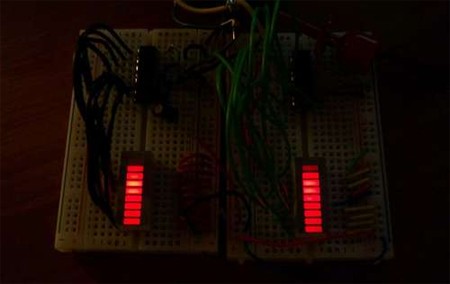
So here’s the situation: you have an audio device, maybe a boombox, perhaps one you built yourself, but it has no VU meter. No problem; building a VU meter is easy with these instructions from [Joe].
You’ll need either an LM3915 or LM3916 chip, a couple of bread boards, two audio jacks, ten LEDs, and a few other components. Wire them all together per the schematic, then plug an audio source into the input jack. You can plug your speakers or output device into the output jack, and you’re done. Keep in mind that LM3916s switch negative, so positive to positive wiring from LEDs to the bread board will be necessary. The wiring on [Joe]’s version is a bit convoluted, but it can be cleaned up on yours if you take the time. Video embedded below.
















this isn’t a hack or anything, you guys are just linking to instructables now. the 3915 has been known for forever as something simple to use as a vu meter. come on post something worthwhile or close doors and shut down. since this new let’s be engadget/gizmodo lite thing happened you guys have really started posting stuff from the bottom of the barrel.
A hack implies using something for an unintended use, the LM3914/5/6 was *designed* for this exact purpose. If we want slashdot or engadjet, we’d go there, filter a little more please
Yeah…I googled the part number…it returned “The LM3916 is a monolithic integrated circuit that senses analog voltage levels and drives ten LEDs, LCDs or vacuum fluorescent displays, providing an electronic version of the popular VU meter.” ….
You could also try pulling one out of an old tape deck- I picked up one for $5 which had a functional VU meter inside (7666p based), along with a bunch of other cool motors and things. Here is a quick write-up:
http://www.cibomahto.com/?s=vu+
Too right guys…. I’ve already been to Engadget and Gizmodo, I don’t need to read the same articles a third time. How about showing us some hacks ?
Not only is this not a hack, but the design for such a beast is available at the end of the chip’s datasheet itself! The guy even entered it into the Robot contest on Instructables… hell, I’m going to copy some circuit verbatim from the datasheet and enter it into contests to win prizes against those who put some real blood, sweat, and tears into a custom design.
Unbunch your panties and man up for five minutes will ya?
Save the drama for rendezvous with rama.
Golly, a LM3915, it has only been around for like FOREVER!
This isn’t instructables.com! This isn’t I-am-a-electronics-idiot.com
This is hackaday! posts some gorram hacks already!
This can be summed up in one word: LAME. I remember playing with that chip 30 years ago, when I was in high school.
Let’s all use this one opportunity of a poor article to prove our superior intellect by pointing out the weakness in others.
“the day you think you know everything about anything is the day when you stop learning”
i never would hire anybody with such arrogance.
I suppose I ought to make the obligatory pedantic comment and point out that this is a level meter, but it’s not technically a VU meter. VU meters have a fairly specific dynamic response.
To be fair the new content has started to improve. Theres been some intersting stuff and some teribly out of place stuff. Lets hope this is just teething, and we’ll level out some where half decent.
This post falls into the out of place category. Its like going up to bunch Head Chefs and saying “Hay check out this egg I boiled!”
The LM3914 used as a proportional fan driver with optional temperature display.
http://ozvalveamps.elands.com/techsite/thermofan/thermofan.htm
Come on, this isn’t a hack at all. Prehaps, the LM3915 it’s very very old, and i think most of we know how to drive it.
If you’ll go this way, you’ve to get a domain like instructable-a-day.com or ad-a-day.com
Juan Aguilar, i don’t know you, but i know that YOU are getting hackaday down and down each day…
Saludos desde Argentina.
Yes it is a very old circuit. I even modified this circuit to use as a voltmeter in one of my cars.
Maybe calling it a hack isn’t correct, but it is usefull anyway. Maybe you need another category called “old but fun crap”.
Batteries + Wires /= Hack
Creaky! Nuther great hack. Keep ’em comin, mates!
Kuuhldom